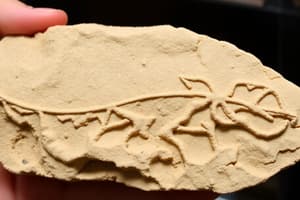Podcast
Questions and Answers
What is Paleontology primarily concerned with?
What is Paleontology primarily concerned with?
- The analysis of geological formations
- The examination of fossils (correct)
- The exploration of climate changes over time
- The study of living organisms and ecosystems
Which field of study does Paleontology belong to?
Which field of study does Paleontology belong to?
- Anthropology
- Meteorology
- Geology (correct)
- Biology
Why is Paleontology important for understanding evolution?
Why is Paleontology important for understanding evolution?
- It focuses solely on modern flora and fauna
- It helps in predicting future climate events
- It provides evidence of historical life forms (correct)
- It reveals current species behaviors
What type of evidence do paleontologists primarily study?
What type of evidence do paleontologists primarily study?
Which of the following statements about Paleontology is accurate?
Which of the following statements about Paleontology is accurate?
Why are Egyptian mummies not classified as fossils?
Why are Egyptian mummies not classified as fossils?
What is the main criterion for fossilization?
What is the main criterion for fossilization?
Which of the following best describes fossils?
Which of the following best describes fossils?
What distinguishes fossils from mummies?
What distinguishes fossils from mummies?
What transforms plants or animals into fossils?
What transforms plants or animals into fossils?
Which factor significantly contributes to the durability of an organism's remains for fossilization?
Which factor significantly contributes to the durability of an organism's remains for fossilization?
What is a characteristic of trace fossils?
What is a characteristic of trace fossils?
Which of the following is NOT a type of fossil mentioned?
Which of the following is NOT a type of fossil mentioned?
In which environment are fossils likely to be buried quickly?
In which environment are fossils likely to be buried quickly?
Which of the following describes body fossils?
Which of the following describes body fossils?
What is the first step in the formation of footprint fossils?
What is the first step in the formation of footprint fossils?
What happens after the impression of the footprint is made?
What happens after the impression of the footprint is made?
What material does the sand eventually consolidate into during the fossilization process?
What material does the sand eventually consolidate into during the fossilization process?
At which stage does the original footprint become visible?
At which stage does the original footprint become visible?
In what type of sediment is the footprint initially formed?
In what type of sediment is the footprint initially formed?
What are considered chemical fossils?
What are considered chemical fossils?
Which of the following is NOT classified as a chemical fossil?
Which of the following is NOT classified as a chemical fossil?
Which of the following accurately describes fossil fuels?
Which of the following accurately describes fossil fuels?
Which statement best describes the production of chemical fossils?
Which statement best describes the production of chemical fossils?
What type of organic materials are primarily associated with chemical fossils?
What type of organic materials are primarily associated with chemical fossils?
Flashcards are hidden until you start studying
Study Notes
Paleontology
- The study of fossils, which are the preserved remains of ancient organisms
- Fossils are formed through natural processes, not human intervention
- Egyptian mummies are not considered fossils because they were preserved by humans
Conditions for Fossilization
- Durability of the organism's body parts (hard, internal or external such as teeth, claws, shells, bones)
- Environment where the organism lived (areas of high deposition, such as marine environments, will quickly bury the organism)
Types of Fossils
- Body fossils: Remains of organisms like whole bodies, teeth, bones, shells, and leaves
- Example: Pleistocene mammoths found in Siberia with hair, flesh, and blood
- Trace fossils: Evidence of organisms' presence or activity (e.g., footprints, tracks, trails, burrows)
- Footprints are often formed in soft mud that is quickly covered by sand and later consolidates into sandstone
- Chemical fossils: Organic compounds produced by biochemical processes (e.g., fossil fuels such as oil, gas, and coal)
Studying That Suits You
Use AI to generate personalized quizzes and flashcards to suit your learning preferences.




